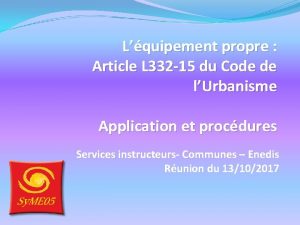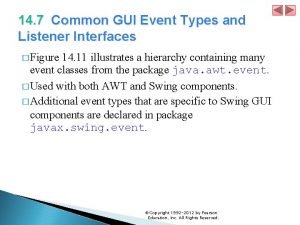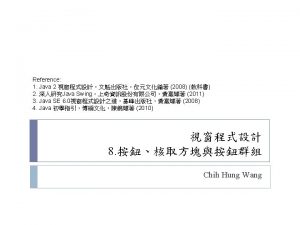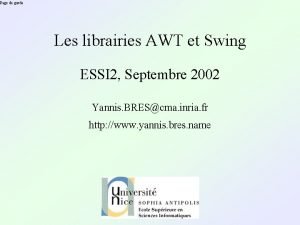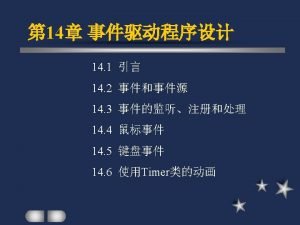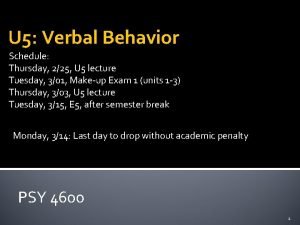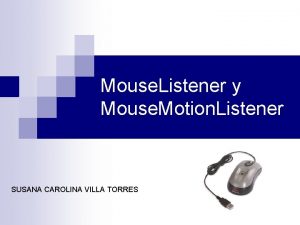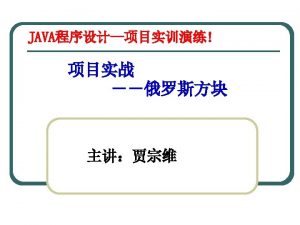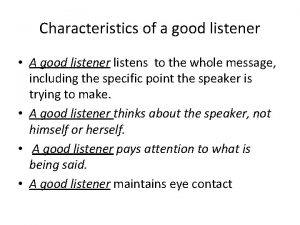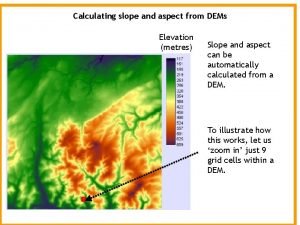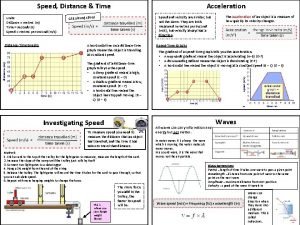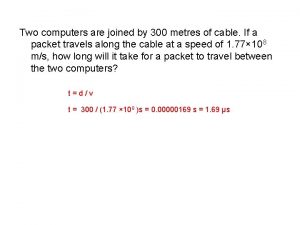speech played several metres from the listener in


















- Slides: 18

• speech, played several metres from the listener in a room - seems to have the same phonetic content as when played nearby - that is, perception is constant • however, amount of reverberation varies with distance: - so temporal envelopes of speech signals vary considerably, and these envelopes are crucial for identifying the speech • seems to be an instance of ‘constancy’ (e. g. Watkins & Makin, 2007) - speech perception ‘takes account’ of reflections’ level: reverberation in preceding sounds effects a compensation (Watkins, 2005)

• real-room reflection patterns: - taken from an office room, volume=183. 6 3 m - recorded with dummy-head transducers, facing each other speaker listener • room’s impulse response (RIR) obtained at different distances, - this varies the amount of reflected sound in signals i. e. : early (50 ms) to late energy ratio: 18 d. B at 0. 32 m → 2 d. B at 10 m, with an A-weighted energy decay rate of 60 d. B per 960 ms at 10 m • RIR convolved with ‘dry’ speech recordings - headphone presentation → monaural ‘real-room’ listening

test words; ‘sir’ vs. ‘stir’ • distinguished by their temporal envelopes - notably, the gap (in ‘stir’ ) before voicing onset • 11 -step continuum: - end-point ‘stir’ (step 10), from amplitude modulation of other end-point, ‘sir’ (step 0) • prominent effect of this AM is the gap amplitude AM function ‘sir’ step 0 200 ms time • intermediate steps, 1 -9, by varying modulation depth ‘stir’ step 10

• apply RIRs to sounds - vary their distances • listeners identify these test words - measure category boundary: • ‘extrinsic’ context: “next you’ll get _ ” mean proportion of ‘sir’ responses constancy paradigm mean category boundary 1. . 5 0. 0 “sir” 5 continuum step 10 “stir”

category boundary, step test far minus test near, steps 8 test word far near 6 • increase test–word distance: - more sir responses - increases category boundary - substantial far-near difference 4 2 near far none near far noise context 6 4 near far none near far noise context • increase context’s distance also: - reduces far-near difference - more ‘constancy’ of test words

category boundary, step test far minus test near, steps 8 test word far near 6 4 2 near far none near far noise context • Nielsen & Dau (2010): - noise context - speech-shaped, un-modulated - behaves like a far context - similar effect here - why? • idea about modulation masking: - obscures gap [t] in ‘stir’ - increases ‘sir’ responses - mainly from the near contexts, where there’s more modulation - mostly affects far test-words 6 4 near far none near far noise context • less modulation masking from: - noise contexts - and from far contexts, hence, ‘constancy’ effect

category boundary, step test far minus test near, steps 8 test word far near 6 • modulation masking → prediction: - no context - even less masking - even smaller far-near difference 4 2 near far none near far noise context • opposite here, so effect is: - compensation from far context - not masking from near context 6 • constancy informed by context: - cue is ‘tails’ that reverb. adds at offsets 4 • near contexts have sharp offsets - clearly, no tails from reverb. near far none near far noise context • other contexts; far, noise: - no sharp offsets; - presence of tails more likely

category boundary, step test far minus test near, steps 8 test word far near 6 • context effects are ‘extrinsic’ - are there any intrinsic effects? i. e. , from within the test word 4 2 near far none near far noise context 6 4 near far none near far noise context • ‘gating’; - removes tail from reverb. , at end of test-word’s vowel

• 1980 s drum sound: - ‘gated reverb. ’ - reduces distance info. drums → ‘foreground’

‘sir’, near 8 frequency, k. Hz 6 4 2 200 ms time

• near → far, adds tails 8 frequency, k. Hz 6 4 2 200 ms time

• far → gated, cuts tails 8 frequency, k. Hz 6 4 2 200 ms time

category boundary, step test far minus test near, steps 8 test word far near 6 } gated • constancy; - is reduced by gating, so: - it’s also informed by intrinsic info. , that arrives after the consonant 4 2 near far none near far noise context • w/ extrinsic contexts - effects of gating not so apparent • competition; extrinsic > intrinsic 6 4 near far none near far noise context

category boundary, step test far minus test near, steps 8 test word far near 6 4 2 near far none near far noise context 6 4 near far none near far noise context } gated • Nielsen & Dau (2010), some no-context data (w/ only the far test words) - compared with near contexts, effects of reverb. were reduced. • same pattern here for constancy: - on removal of extrinsic influence, intrinsic effect emerges

• constancy is not effected by modulation masking (or ‘adaptation’): - this is consistent with data on detection of sinusoidal AM (Wojtczak & Viemeister, 2005; speech mod. frequencies are too low) - and with ‘extrinsic’ compensation from preceding contexts in speech (Watkins, 2005; contexts w/ reversed reverb. don’t → compensation) • there is also some ‘intrinsic’ compensation, from within test words - informed by tails that arise after the test-word’s consonant - less influential than the extrinsic compensation from preceding contexts, so its effects only emerge with isolated test-words


harp in harp out

‘sir’, far; gated 8 frequency, k. Hz 6 4 2 200 ms
 Began begin
Began begin If you were grammar
If you were grammar A ball dropped vertically falls d metres
A ball dropped vertically falls d metres L332-15 enedis
L332-15 enedis I should take a local area orientation dive whenever i
I should take a local area orientation dive whenever i Dcrire
Dcrire Skills communication
Skills communication Database listener
Database listener Pseudolisteners
Pseudolisteners It takes a great man to be a good listener meaning
It takes a great man to be a good listener meaning Gui events
Gui events Java listener
Java listener Fabric event listener
Fabric event listener Event
Event Elastic disk provisioning architecture
Elastic disk provisioning architecture Good listener
Good listener Jframe close listener
Jframe close listener Automated scaling listener
Automated scaling listener Intraverbal examples
Intraverbal examples



